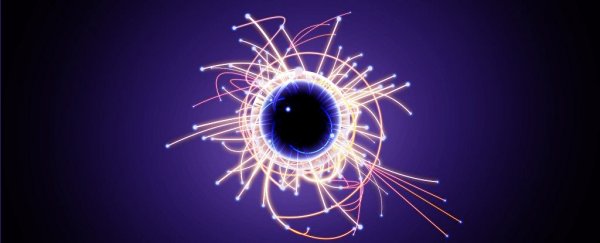Physicists working at the Large Hadron Collider have made a major new detection of the famous Higgs boson, this time catching details on a rare interaction with one of the heaviest fundamental particles known to physics - the top quark.
The brief mingling of these incredibly rare encounters has provided physicists with important information on the nature of mass, and whether there is more to physics than the existing model predicts.
Results produced by the ATLAS and CMS experiments from the European Organization for Nuclear Research (CERN) help confirm the strength of the bond between Higgs bosons and top quarks.
Since Higgs bosons are responsible for the mass of fundamental particles, getting hard data to compare with predictions is cause to celebrate.
In spite of dealing with mass every day – either in the form of gravity's pull or in overcoming inertia to get our body moving – getting your head around its basic cause is tricky.
Einstein's famous E=mc^2 equation is a description of mass as energy. Sticking basic particles together into neutrons and protons requires energy, and that effort contributes to the sense of heaviness of an atom.
Here's the thing: certain fundamental particles still have mass even when they aren't exercising any effort. So where does their mass come from?
Fifty years ago, a scientist named Peter Higgs figured there had to be a boson – a particle in the same particle category as photons – that interacted with them within a special field, filling in that tiny missing bit of energy that completes an object's mass.
For decades, this odd little particle was the missing piece of the Standard Model puzzle – the last remaining fundamental particle to be experimentally confirmed. Finally, in 2012, rumours that Higgs' boson was spotted in the Large Hadron Collider were confirmed, and with that the Standard Model was complete.
As amazing as it was, that's just the start of our exploration of Higgs boson. We still need to measure that tiny bit of effort that's responsible for the missing mass - and top quarks are a good place to start looking.
Their siblings – up and down quarks – are what make up protons and neutrons. But top quarks don't stick around long enough to make much of anything most of us would recognise, decaying in a split second.
They are remarkably heavy, though. An electron has roughly one three-millionth the mass of a top quark, indicating a relatively strong interaction with the Higgs field.
Catching this interaction requires having hints of a Higgs boson appearing together with a top quark in something called a ttH production. This is easier said than done. Neither particle exists long enough to be seen directly, and only 1 percent of Higgs bosons produced by the energies of the LHC appear alongside a top quark.
To spot them, physicists needed to trawl through the data from two different collider experiments in search of signature combinations of the less unstable particles they break into.
It's like finding measurements of how hard two celebrities shook hands at an exclusive party after they've already gone home. Only much more difficult.
By finding enough 'celebrity handshakes' and comparing their results, the researchers of both experiments are now confident they have the right numbers to describe the strength of a Higgs-top quark coupling.
"These measurements by the CMS and ATLAS Collaborations give a strong indication that the Higgs boson has a key role in the large value of the top quark mass," says physicist Karl Jakobs, spokesperson of the ATLAS collaboration.
"While this is certainly a key feature of the Standard Model, this is the first time it has been verified experimentally with overwhelming significance."
More information is set to be collected in coming months, in the hope of getting a more precise figure that could provide hints of something less expected.
"When ATLAS and CMS finish data taking in November of 2018, we will have enough events to challenge even more strongly the Standard Model prediction for ttH, to see if there is an indication of something new," says the CMS collaboration spokesperson Joel Butler.
It's more of a 'fingers crossed' situation than a solid expectation. But there's still some big mysteries in physics, including the question of why stuff exists at all.
Any sign of something new is high on a particle physicist's wish list.
This research was published in Physical Review Letters.
